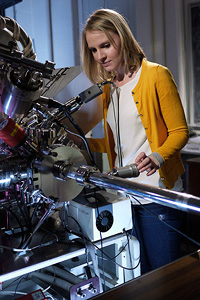 |

|
 |
Amy Marquardt using X-ray photoelectron spectroscopy to analyze the surface chemistry of silver and bronze. |
|
Department of Materials Science and Engineering (MSE) graduate student and Ph.D. candidate Amy Marquardt was awarded first place in the 2014 Dean's Doctoral Research Award Competition for her dissertation, “Application of materials science to cultural heritage: Protecting Art with Nanotechnology.”
Marquardt, advised by Professor Ray Phaneuf (MSE), is using her expertise in materials science to help museum conservators analyze, clean and preserve their art and artifacts. For the past several years, she has been part of a team working with conservators from the Walters Art Museum to develop nanometers-thick coatings that protect silver from tarnish. The material, applied using atomic layer deposition (ALD), is currently being tested on an artifact from the museum’s collection. The project has been reported by Science, highlighted by the American Physical Society and the American Vacuum Society, and was the subject of a National Science Foundation video.
Marquardt recently participated in an international research exchange program at the University of Trento, Italy, where she worked with Massimo Bersani at the Fondazione Bruno Kessler. Her project focused on the development of a kinetics model for the corrosion and tarnishing of metal cultural heritage objects. She also continued her work on the optimization of atomic layer deposited metal oxide films that could be used to protect them.
Her efforts have earned her a 2014-2015 research-in-residence fellowship at the Smithsonian’s Museum Conservation Institute (MCI), where she will collaborate on a project that could create a more effective way to preserve bronze art and artifacts. In a previous internship at the MCI, she used microscopy, microanalysis, and spectroscopy to determine the color, mineralogy, and stability of artificial bronze patinas used by conservators to restore the appearance of and protect an object after it’s cleaned.
Now, on her return, she’ll draw on that experience, her time in Italy, and her collaboration with the Walters as she works with Research Scientist Edward Vicenzi, Senior Objects Conservator Carol Grissom, and Phaneuf to evaluate the ability of ALD coatings to protect bronze patinas. The team will also determine what techniques are required to remove them from an artifact without altering or damaging it.
“So far my ALD coating research has focused on silver, which represents an ideal substrate because it has a uniform surface chemistry,” Marquardt explains. “The Smithsonian houses a large number of bronze art and cultural heritage objects from around the world and throughout time. These objects often have a natural or applied patina–an oxide surface layer–whose preservation is challenging because their surface chemistry is extremely complex, non-uniform and sensitive to atmospheric corrosion. With silver, the tarnish layer is typically removed to leave a clean surface; however, patina compositions can vary depending on the object’s age, environmental exposure or chemicals used during patination. The big question is whether ALD barrier coatings can be used on, and to stabilize, these non-ideal surfaces while meeting the rigorous standards of art conservation. I am very excited about this unique opportunity to find out!”
Dean Darryll Pines created the Dean's Doctoral Research Award Competition in 2009 to give top Clark School doctoral student researchers special recognition, and to demonstrate to all students the importance of high quality engineering research.
“The judges were impressed with Amy’s ability to utilize a novel scientific approach for the protection of heritage artifacts [and] were specifically impressed with the clarity and completeness of her presentation,” says Pines. “[Her] research accomplishments are a testament to the level of scholarship produced by Clark School students and faculty members.”
Related Articles:
Museum Conservation Research Wins Top Prizes in International 3-Minute Thesis Competition
Using Materials Science and Engineering to Save Priceless Artifacts
Vote Now! Materials Video Enters Thinkable Competition
Vote Now! Materials Grad Student is Finalist in 3 Minute Thesis Competition (VIDEO)
Atoms-Thick Coating Ready for First Test on Silver Artifact
See How Materials Scientists and Conservators are "Silver Savers"
Materials Scientists, Conservators Join Forces to Preserve Silver Artifacts and Art
May 21, 2014
|